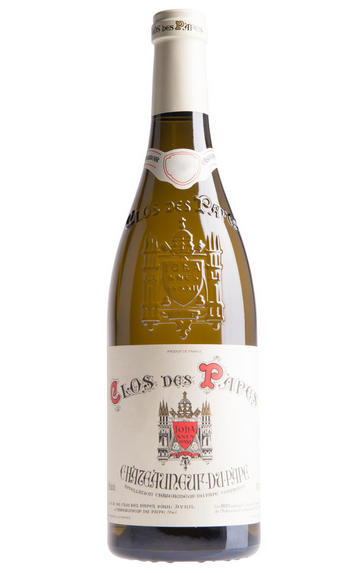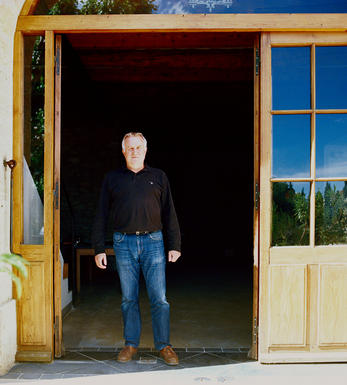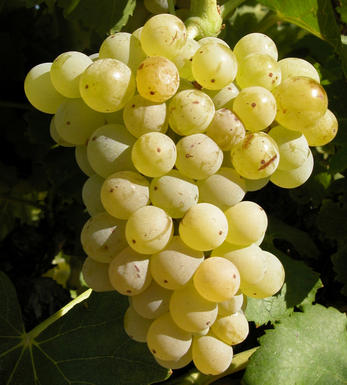
2011 Châteauneuf-du-Pape Blanc, Clos des Papes, Paul Avril & Fils, Rhône

Critics reviews
Robert M. Parker, Jr. - 31/10/2012
Jancis Robinson MW, jancisrobinson.com – 26 Feb 2013
This admirably run estate has essentially been practicing biodynamic farming for nearly 15 years, but they were not certified as biodynamic until 2011.
Robert Parker, Wine Advocate #204, Dec 2012
About this WINE

Paul Avril et Fils
With Vincent Avril at the helm, Clos des Papes is one of the most highly regarded properties; not only in Châteauneuf-du-Pape, but in the world of wine. This family estate has been certified organic for 15 years, with high attention to detail translating into impressively low production levels. Given that the vines here average over 50 years of age, they are firmly prepared and able to withstand many ordeals, including Mistral winds at 140 kilometres an hour, severe heatwaves and drought conditions. Thankfully, they were spared from the latter two in 2020.
When you visit this iconic estate, what stands out most is the complete focus on the vineyard and the absolutely hands-off approach in the cellar. The wines are amongst the purest expression of terroir you could ever wish to taste. There is a magic here that transcends the liquid in the bottle – Clos des Papes is a nonpareil of sheer brilliance.
Vincent is exceptionally happy with his ’20 wines, saying, “I can tell you ’20 is, I think, a great year that will stand the test of time. A very balanced, fine vintage with great freshness, silky tannins and good length in the mouth. Everything was climatically united, both for the red and the white. Currently, ’20 reminds me of ’05 and ’07.”

Châteauneuf-du-Pape
The most celebrated village of the Southern Rhône, Châteauneuf-du-Pape is the birthplace of the now indispensable French Appellation d’Origine Contrôlée system – imperfect though it may be. Compared to the Northern Rhône, the vineyards here are relatively flat and often feature the iconic galet pebbles – the precise benefits of which are a source of much debate. Minimum alcohol levels required by the AOC are the highest in France, but at 12.5% it is well below the natural generosity of Grenache, which only achieves its full aromatic potential when it is fully ripe and laden with the resultant high sugars. Syrah and Mourvèdre contribute the other defining elements in the blend, adding pepper, savoury spice and structure to the decadent Grenache. There are a further 10 permitted red grape varieties which can be used to adjust the “seasoning”. Of the five white varieties permitted, it is Grenache Noir’s sibling – predictably perhaps – Grenache Blanc, which dominates, though Roussanne shows a great deal of promise when handled well, notably at Château de Beaucastel.

White Rhône Blend
With the exception of the wines from Condrieu and Château-Grillet virtually all Rhône Valley whites are made from blends.
In the north, the white wines of Hermitage, Crozes-Hermitage, St-Joseph, and St-Péray are produced from blends of Marsanne and Roussanne. Generally Marsanne is the dominant partner and it lends colour, body and weight to the blend, as well as richly scented fruit. Roussanne, a notoriously low yielder and pernickety to grow, produces intensely aromatic wines which contribute bouquet, delicacy and finesse to the blend.
Until about 15 years ago there was very little interest in southern Rhône whites as it was widely believed that the combination of dull non aromatic grapes and the baking summer heat meant quality wine production was nigh impossible. Since then the quality has improved markedly through the introduction of cool fermentation techniques and increased plantings of northern Rhône white grapes.
The base of many blends is still Grenache Blanc, a widely planted variety producing fresh wines with apple-like fruits, often with hints of aniseed. Ugni Blanc is still found in many blends, as is Clairette though their general lack of character and definition has led to a reduction in plantings. The future for southern Rhône whites appears to lie with Roussanne, Marsanne, and, increasingly, Viognier.


Buying options
Add to wishlist
Description
This is a wonderful blend of all the permitted white Châteauneuf-du-Pape grape varietals. Very complex with almond, mineral and lime characters leading to hints of honey and ground nuts that this style develops, given time. The aromatics keep changing with floral prettiness, mineral notes and white pepper dominating the long finish.
Laura Atkinson, Private Account Manager
All six white varieties are given pretty much equal billing here (Grenache Blanc, Clairette, Picardin, Bourboulenc, Roussanne and Picpoul, as if you didn’t know). The white goes through three distinct ages; from almost tropical hazelnut and pineapple favours of youth, to Riesling almond essence fascination after seven years and then finally, later on, to the calm wisdom begat of honey, flint and remembrance of times past.
Simon Field MW, BBR Buyer
A variety of pleasing coincidences allowed me to taste chez Vincent Avril no fewer than three times in 2012, a huge, rare privilege and proof, were proof needed, of his dedication and thoughtful approach to vinification. He compares 2011 to 2001, but also senses that it has 2/3 of the character of 2009 and 1/3 of 2008. His love of Mourvèdre over Syrah is cleverly illustrated and his anxiety at the fact that over 70% of the village’s crop is sold en vrac perhaps explains that in order to make wine as superlative as this, one has to farm at a parsimonious 18 hl/hr.
wine at a glance
Delivery and quality guarantee